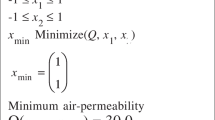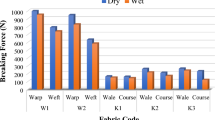Abstract
In this study, the thermal protective performance of nonwoven fabrics made of Nomex (polyisophthaloyl metaphenylene diamine), PPS (polyphenylene sulfide), P84 (polyimide), and basalt fibers was investigated. The objective was to determine the influence of fiber type, thickness of fabric, and wet on the thermal protective performance of nonwoven fabric. The thermal resistances of different nonwoven fabrics were measured using a dry hot plate instrument, the basalt nonwoven fabrics had a highest thermal resistance in all fabric, and the thermal resistance of nonwoven fabric increased with the increase in thickness. The six nonwoven fabrics were exposed to a hot environment for a few minutes by using a self-designed apparatus. The test results showed that the nonwoven fabrics made with basalt fiber exhibited the best thermal protective performance, and the thermal protective abilities of nonwoven fabrics increased with fabric thickness. Interestingly, nonwoven fabrics with added water were found to be able to keep the fabric surface lower temperature compared to dry fabrics when exposed to a hot environment, indicating the excellent thermal protective performance of wet nonwoven fabrics.






Similar content being viewed by others
References
Lizák P, Legerska J, Militký J, Mojumdar SC. Thermal transport characteristics of polypropylene fiber-based knitted fabrics. J Therm Anal Calorim. 2012;108:837–41.
Lizák P, Legerska J, Mojumdar SC. Influence of knitted structures on heat transfer. J Therm Anal Calorim. 2013;112:1089–94.
Hao LC, Yu WD. Evaluation of thermal protective performance of basalt fiber nonwoven fabrics. J Therm Anal Calorim. 2010;2:551–5.
Hao LC, Yu WD. Comparison of thermal protective performance of aluminized fabrics of basalt fiber and glass fiber. Fire Mater. 2011;35:553–60.
Mohammadi M, Banks-Lee P. Determining radiative heat transfer through heterogeneous multilayer nonwoven material. Text Res J. 2003;73(10):896–900.
Rahul V, Pamela Be, Massoud M. Determination of radiative thermal conductivity in needlepunched nonwovens. J Eng Fibers Fabr. 2008;3(4):46–9.
Sungho L, Do-Hwan K, Jae-Ha P, Bon-Cheol K. Effect of curing poly(p-phenylene sulfide) on thermal properties and crystalline morphologies. Adv Chem Eng Sci. 2013;3:145–9.
Song GW, Paskaluk S, Sati R, Crown E. Thermal protective performance of protective clothing used for low radiant heat protection. Text Res J. 2012;81:311–23.
Cai GM, Yu WD. Study on the thermal degradation of high performance fibers by TG/FTIR and Py-GC/MS. J Therm Anal Calorim. 2011;2:757–63.
Małgorzata M, Krzysztof S. Influence of the structure of woven fabrics on their thermal insulation properties. Fibres Text East Eur. 2011;88:46–53.
Hrynyk R, Frydrych I, Irzmanska E, Stefko A. Thermal properties of aluminized and non-aluminized basalt fabrics. Text Res J. 2013;83(17):1860–72.
Barker RL, Guerth C, Hamoud H. Effects of moisture on the thermal protective performance of firefighter protective clothing in low-level radiant heat exposures. Text Res J. 2006;76(1):27–31.
Wang Yy LuYh, Jun Li. Effects of air gap entrapped in multilayer fabrics and moisture on thermal protective performance. Fibers Polym. 2012;13(5):647–52.
Huang JH. Sweating guarded hot plate test method. Polym Test. 2006;25(5):709.
Militky J, Kovacic V, Rubnerova J. Influence of thermal treatment on tensile failure of basalt fibers. Eng Fract Mech. 2002;69(9):1025–33.
Acknowledgements
We wish to thank the Hubei Provincial Department of Education through project (144011) for the financial support.
Author information
Authors and Affiliations
Corresponding author
Rights and permissions
About this article
Cite this article
Cai, G., Xu, Z., Li, W. et al. Experimental investigation on the thermal protective performance of nonwoven fabrics made of high-performance fibers. J Therm Anal Calorim 121, 627–632 (2015). https://doi.org/10.1007/s10973-015-4698-6
Received:
Accepted:
Published:
Issue Date:
DOI: https://doi.org/10.1007/s10973-015-4698-6




